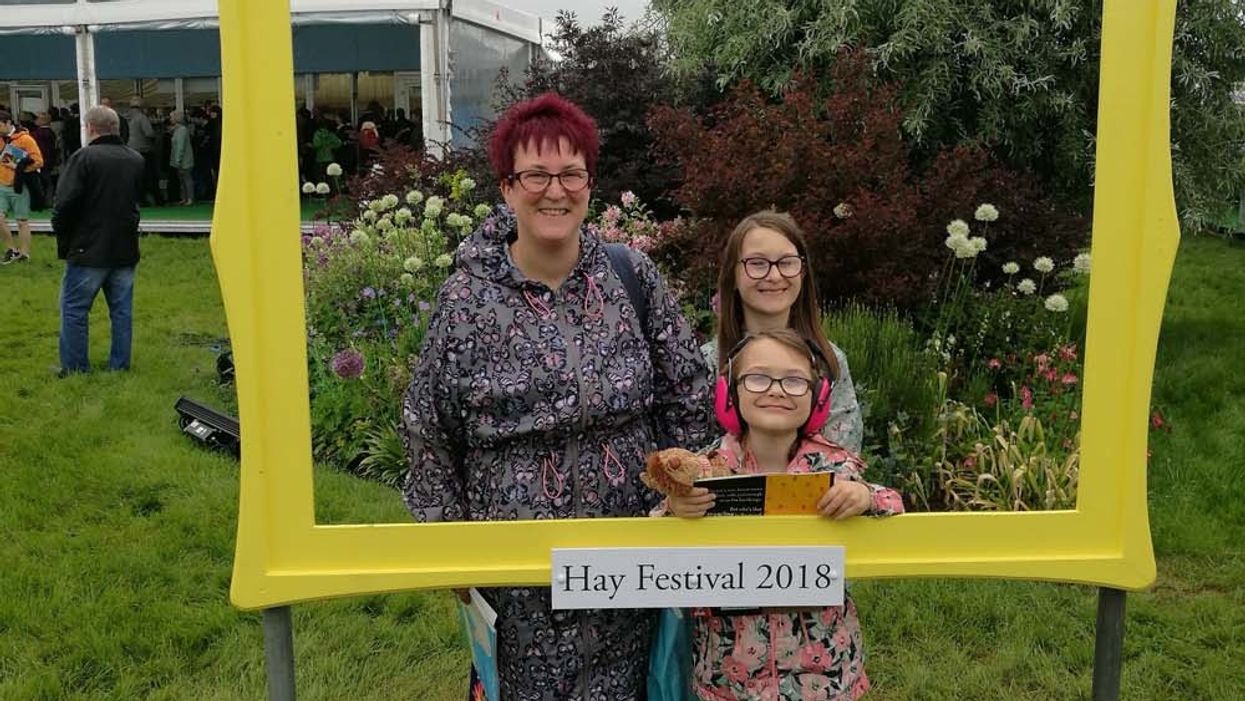A mum has praised the incredible bravery of her two little girls – struck down by an ultra-rare condition affecting less than one per cent of the population – which is turning their bodies to stone.
Now their full-time carer, Alison Beesley revealed how her daughters, Eliza, nine, and Eleanor, six, both live with scleroderma, a chronic disease where the immune system becomes overactive and attacks the body, causing the skin and connective tissue to harden.
According to SRUK, the charity for the condition, the siblings account for just one per cent of scleroderma sufferers who develop the cruel autoimmune condition alongside a relative.

Yet Alison, 45, of Conisbrough, South Yorkshire, who also has an older daughter she does not wish to name, said her girls show admirable fortitude, adding:
“They are such special girls. They rarely moan or complain. Eleanor struggles a little with the regular blood tests she has to have, but that's because she also has some sensory issues."
“It can take a really long time for scleroderma to get diagnosed, especially in children. So, I'm sharing my story to show people what to look out for, and encourage others to push for tests that could help."
“With something as rare as this, it's not always a case of going home from the doctors quietly. Sometimes, I think doctors don't know best – parents do. And I will always fight for my girls."

Alison, who worked as a teaching assistant before she became her daughters' carer in June 2018, told how the first sign that anything was wrong came in the form of a tiny mark under Eliza's armpit when she was three.
She said:
“It looked almost bruise-like. I wasn't especially worried at first – after all, kids get bruises."
“But after a week, it still hadn't gone, or even changed colour like normal bruises do when they begin to heal."
Concerned, Alison, who is no longer with her childrens' father, took Eliza to the GP, who initially thought she had a simple fungal infection and prescribed some cream.
But that did little to improve her symptoms and, before long, another patch sprang up, this time on her right hip.
Alison recalled:
“We went back to the GP and were given some different fungal cream, but something didn't ring right."

“I went away and did a lot of Googling, but nothing was coming up that seemed to match Eliza's symptoms."
Meanwhile, another mark appeared on Eliza's left hip and rapidly grew, prompting a third visit to the doctor, where a referral to a dermatologist was made.
“I'd still been Googling away when one day, a page about scleroderma came up. It described what had been happening to a tee. Finally, we were getting some answers," Alison said.
Leaping into action, she soon found SRUK – the UK's only charity dedicated to improving the lives of people affected by scleroderma and Raynaud's – which had compiled a useful list of medics specializing in the condition.
Contacting an expert at Liverpool's Alder Hey Children's Hospital, she pleaded for help.
“I said, 'I know you probably can't diagnose over email, but I'm sure my daughter has scleroderma,'" she continued.

“I sent over some pictures, and wasn't really expecting to hear back – after all, these people are incredibly busy."
“But within a day, I had a reply saying that, while I'd need a proper diagnosis and second opinion, on the surface, it looked like I was right."
Finally, in June 2014, around a year after her symptoms had started, Eliza was officially diagnosed with localized scleroderma.
According to SRUK, this is where cells in the body known as fibroblasts make too much collagen, causing the skin – and sometimes, the tissues beneath it – to scar and thicken.
The same day as her diagnosis, she began treatment – a course of immunosuppressants called methotrexate, more commonly used as a chemotherapy drug for cancer patients, followed by steroids.
“She managed really well. She's a real little trooper, and barely flinched at all the tests and hospital visits," said Alison.

“Over time, the patches on her hips weren't that noticeable anymore, but then new ones started to form on her thighs, knees, feet, chin and nose."
When Eliza was around five-and-a-half, doctors decided to switch her to a different form of medication – this time, to be given in injection form.
Alison continued:
“That was difficult. She'd get really worked up, to the point where she would run and hide under the bed."
“It was so difficult as I knew the injections were to help her, but she was too young to understand that."
“It got to the point where she was physically having to be held down – and that's when I said, 'enough is enough.' I just couldn't put her through that anymore."
So, after a year, Eliza switched back to the tablet form of a drug called mychophenolate mofetil, which she continues to take twice a day.

For a while, life ticked along as normal for the Beesley family, then in early 2018, when history appeared to repeat itself.
Alison explained:
“A mark very similar to the one Eliza had appeared on the inside of Eleanor's left ankle. I did wonder if she'd just banged it, but deep down, I think I knew what was coming, and thought to myself, 'Here we go again'."
“This time, though, I knew what I was looking for, so I watched and waited to see what would happen, then told the doctor as soon as it spread to her other ankle."
“As scleroderma presents differently in every patient, though, and there are so many different types, we still had to go to Sheffield Children's Hospital before a second opinion confirmed the diagnosis in November 2018."
Now, Eleanor, whose marks have also spread down her spine, is on the same medication as her big sister.
As the odds of them both having the condition are so rare, there is no data to confirm how many other siblings there are out there like them.
However, there is one known study from 1981 reporting three siblings with scleroderma.
While it remains uncertain what challenges the illness will present to the brave sisters in the future, Alison is determined to help life as normal as possible for them, and to use all the family has been through to help others.
Speaking out during June's Scleroderma Awareness Month, she said:
“I do worry about the girls growing up self-conscious of their marks. Right now, they are perfectly happy to talk about them and just call them their 'patches' – but I know that could change when they get older, and reach the age where you are naturally a little insecure."

“Still, I am determined to speak out to raise awareness. Because scleroderma is so rare, sometimes not even doctors know what to look out for."
“Doctors have told us the condition could burn out in roughly seven years, but there will always be a chance of recurrence for the rest of their lives."
“But if our story helps just one family out there to get a diagnosis quickly, I'll be happy."
For information, visit www.sruk.co.uk








 @TrinityMustache/X
@TrinityMustache/X @AnatoliUkraine/X
@AnatoliUkraine/X @ronsparks.ca/Bluesky
@ronsparks.ca/Bluesky @sycamoressource/X
@sycamoressource/X @Stephen52534304/X
@Stephen52534304/X @plaintanjane/Bluesky
@plaintanjane/Bluesky @alycemiller/Bluesky
@alycemiller/Bluesky






 House Oversight Committee
House Oversight Committee @JayShamsX
@JayShamsX


 @ceoofhoesmad/TikTok
@ceoofhoesmad/TikTok @showmeurmoomoo/TikTok
@showmeurmoomoo/TikTok @cablehoe/TikTok
@cablehoe/TikTok @samanthagibson46/TikTok
@samanthagibson46/TikTok @ikranamoktoyu/TikTok
@ikranamoktoyu/TikTok @hopeyoufindyourdad/TikTok
@hopeyoufindyourdad/TikTok @lexytheactress/TikTok
@lexytheactress/TikTok @athenasworld95/TikTok
@athenasworld95/TikTok @kelsibell24/TikTok
@kelsibell24/TikTok @sydneywynder/TikTok
@sydneywynder/TikTok @vickbash/TikTok
@vickbash/TikTok @xp.etros/TikTok
@xp.etros/TikTok